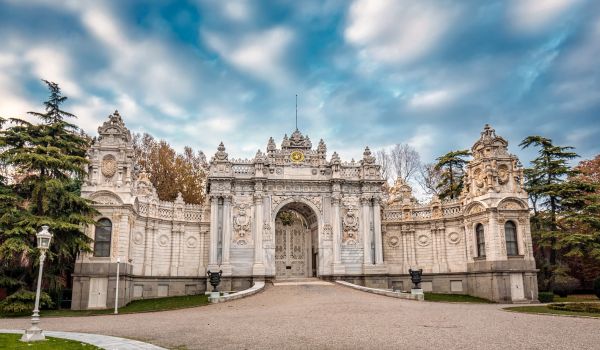
Dolmabahce Palace Overview
Dolmabahce Palace, situated in Istanbul, Turkey, is a magnificent testament to the grandeur of the Ottoman Empire. Built in the mid-19th century, this architectural marvel showcases a harmonious blend of European and Ottoman design elements. With its picturesque waterfront location and meticulously landscaped gardens, the palace’s exterior exudes elegance. Inside, the palace reveals a world of opulence and luxury, boasting stunning chandeliers, intricate ceiling designs, and ornate furnishings. As a museum today, Dolmabahce Palace offers visitors a captivating glimpse into the history and culture of the Ottoman Empire, allowing them to explore its grand halls and marvel at its impressive art collections. A visit to Dolmabahce Palace is an unforgettable experience that transports visitors to a bygone era of Ottoman splendor.
Historical Background
Dolmabahce Palace, an architectural gem located in Istanbul, Turkey, has a rich historical background. Construction of the palace began in 1843 and was completed in 1856, during the reign of Sultan Abdulmecid I. The palace was commissioned as a symbol of the Ottoman Empire’s modernization efforts, blending European and Ottoman architectural styles. It served as the primary residence for the sultans and their families, as well as a venue for hosting important events and receiving foreign dignitaries. Today, Dolmabahce Palace stands as a museum, offering visitors a glimpse into the opulent lifestyle of the Ottoman rulers. To explore this historical treasure, visitors can purchase Dolmabahce Palace tickets, allowing them to delve into its grand halls and discover its remarkable art collections and exquisite interior design.
Exterior Features of Dolmabahce Palace
Dolmabahce Palace, nestled along the picturesque waterfront of Istanbul, boasts remarkable exterior features that add to its allure. The grand entrance and gates of the palace make a striking first impression, with their intricate designs and regal presence. The palace’s facade, with its majestic architecture, stands as a testament to the opulence of the Ottoman Empire. Its stunning waterfront location offers breathtaking views and adds to the palace’s charm. Complementing the architectural splendor, the palace is surrounded by beautifully manicured gardens, adorned with vibrant flowers and lush greenery. The meticulously landscaped grounds provide a serene and picturesque setting, inviting visitors to explore and soak in the beauty that surrounds Dolmabahce Palace.
Interior Design and Decorations
The interior of Dolmabahce Palace is a mesmerizing display of opulence and artistic brilliance. As visitors step inside, they are greeted by a world of exquisite design and lavish decorations. The palace’s vast interior spaces are adorned with opulent furnishings, from intricately carved wooden furniture to luxurious upholstery. The grand chandeliers hanging from the ceilings illuminate the rooms with their sparkling brilliance. The ceilings themselves are adorned with intricate designs and ornate details, showcasing the fine craftsmanship of the artisans. Adorning the walls are magnificent paintings and artwork, depicting scenes from Ottoman history and showcasing the artistic talent of the era. Every room within Dolmabahce Palace tells a story of luxury and grandeur, providing visitors with a captivating glimpse into the lavish lifestyle of the Ottoman rulers.
Main Sections of Dolmabahce Palace
Dolmabahce Palace is comprised of several main sections that highlight different aspects of its grandeur and historical significance. The Ceremonial Hall, with its awe-inspiring dimensions and lavish decorations, served as the venue for important ceremonies and state events. The Crystal Staircase, a magnificent architectural feature, captivates visitors with its intricate design and historical significance. The Harem Section offers a glimpse into the private quarters of the royal family, showcasing the opulent lifestyle of the sultans and their consorts. The State Rooms, including the Throne Room and the Red Room, exhibit exquisite furnishings and elaborate details, providing insight into the grandeur and power associated with the Ottoman Empire. Each section of Dolmabahce Palace offers a unique experience, allowing visitors to immerse themselves in the grandeur and historical significance of this architectural masterpiece.
Dolmabahce Palace Museum
Dolmabahce Palace, once the residence of Ottoman sultans, has now been transformed into a captivating museum that showcases the rich history and cultural heritage of the Ottoman Empire. As visitors step inside, they are greeted by an array of artifacts, historical exhibits, and opulent interiors that transport them back in time. The museum meticulously preserves the grandeur of the palace, allowing visitors to explore its grand halls, admire the ornate decorations, and immerse themselves in the regal atmosphere. The displayed artifacts include exquisite furniture, intricate textiles, stunning artworks, and precious heirlooms, all of which provide valuable insights into the lifestyle and traditions of the Ottoman rulers. Dolmabahce Palace Museum serves as a window into the past, offering a fascinating journey into the opulent world of the Ottoman Empire.
Dolmabahce Palace Gardens
The Dolmabahce Palace Gardens is an enchanting oasis of natural beauty that surrounds the magnificent palace. Spanning across a vast expanse, these meticulously designed gardens offer a serene and picturesque escape from the bustling city of Istanbul. Lush green lawns, vibrant flower beds, and meticulously trimmed hedges create a harmonious landscape that captivates visitors. The gardens feature various elements, including fountains, statues, and pathways, which add to their charm and elegance. From the gardens, visitors can enjoy breathtaking views of the Bosphorus, enhancing the overall experience. The Dolmabahce Palace Gardens are not only a visual delight but also hold cultural and historical significance, providing a tranquil setting for visitors to relax, rejuvenate, and appreciate the beauty of nature.
